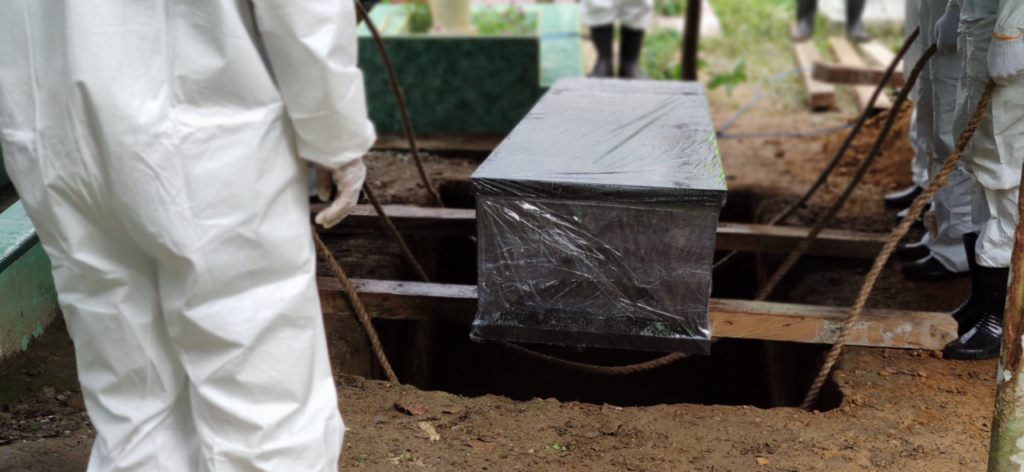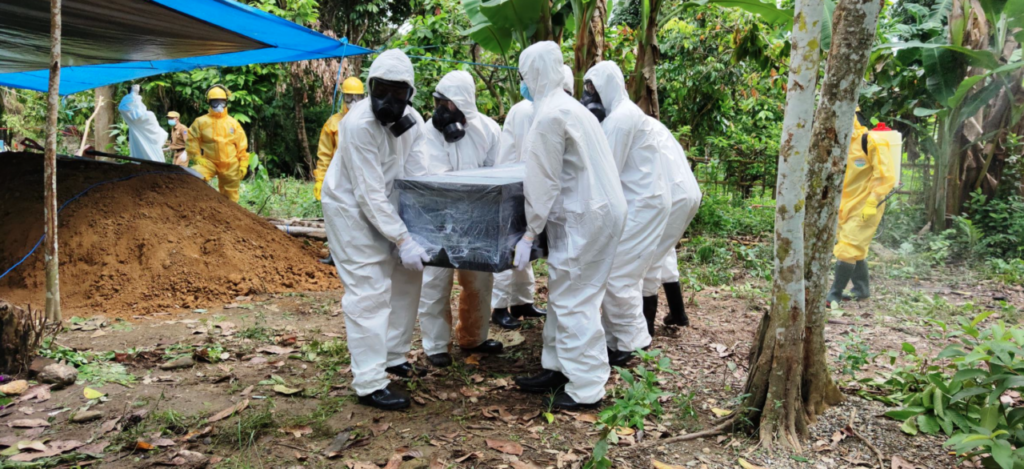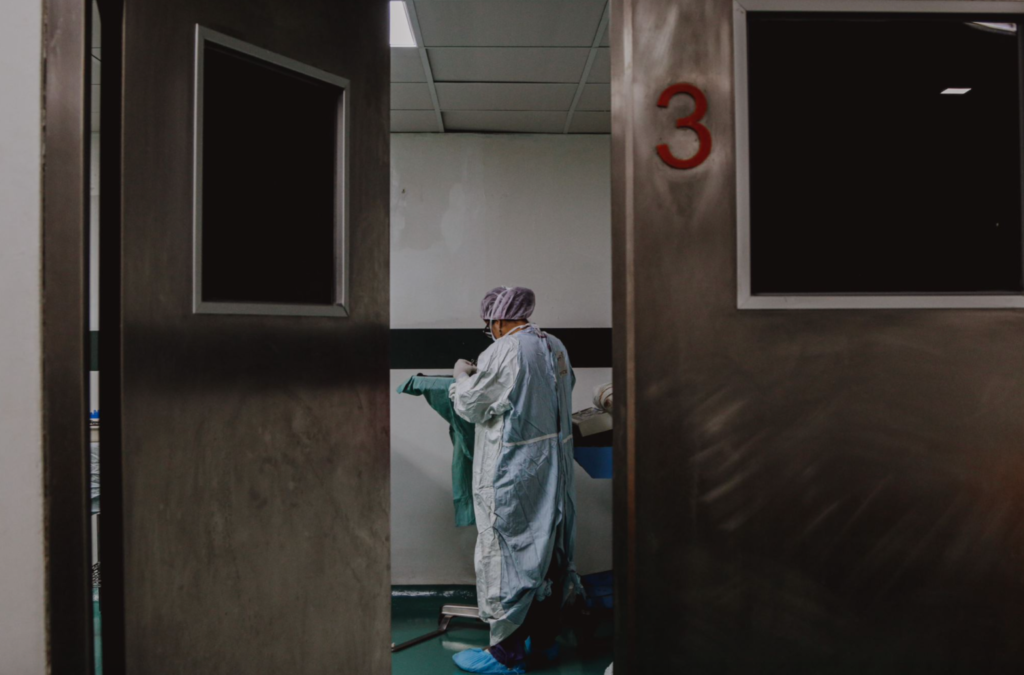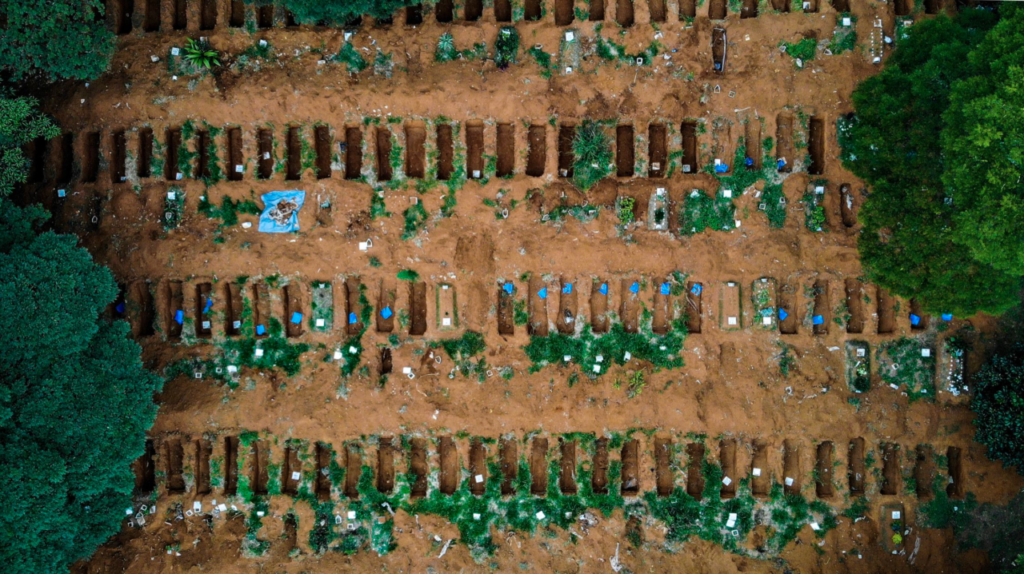Humanitarian deathcare: An oxymoron or a tautology?
Death is a natural and expected part of disasters. Especially pandemics. Nonetheless, it is an occurrence of which we speak relatively little of in terms of practicalities – even as humanitarians. Humanitarian action is typically understood as a range of activities that seek to alleviate human suffering and protect the dignity of all victims of armed conflict and catastrophes, carried out in accordance to certain principles. While humanitarian needs are basic life sustaining needs, they look different seen from the various stages of life. Contemporary humanitarianism focuses on saving lives, and the tale of the humanitarian imperative thus chronologically ends at death (Fassin 2012).
Defining feasible and fruitful scopes of humanitarian activities is a persistent concern to both academia and the implementing sector. Often the topic of the humanitarian-development nexus or exit strategies take centerstage in such discussions. But how far should the horizon of humanitarian concern stretch in terms of providing care when saving lives (the main aim of contemporary humanitarianism) is out of the picture? What role does humanitarian action play in the improvement of life at its very final stages and end?

Safe and dignified
International humanitarian law obliges dignified management of the dead, and the ICRC Guiding Principles state that the dead should be treated with respect and dignity. The activities related to this responsibility (such as palliative care, management of bodies, assisted rituals, support of next of kin etc.) interrelate greatly. While humanitarianism focuses on ‘saving’ lives (Fassin 2012), shifting from healthcare to deathcare in humanitarian settings can become a necessary. Public authorities as well as humanitarian actors thus need to develop solid strategies to manage increased mortality at large scale.
This type of response is sometimes referred to as deathcare or forensic humanitarianism (Cordner and Tidball-Binz 2017). Guiding these practices, protocols for ‘safe and dignified burials’ are an essential part of containing any epidemic outbreak. This means that along with the many guidelines on health precautions and hygiene promotions that have been campaigned in settings with humanitarian presence as well as everywhere else during this pandemic, numerous protocols and policies have been developed to provide guidelines on how to safely and professionally manage the dead in a dignified manner.
Management of the dead is – even in humanitarian settings – a sensitive task. Despite the universality of the occurrence of death, the meaningful practices that surround the event are immensely diverse. With such diversity, the provision of end-of-life assistance or deathcare is hardly standardizable (Harrell-Bond and Wilson 1990).
In the Sphere standards, proper management of bodies belongs under WASH in the section on ‘Waste management’. This categorization, while being rather grim, makes practical sense, but it is needless to say that the care which is necessitated by events of mass fatality spans the realm of the WASH sector alone.
Preparing for mass mortality is by all means an unwanted necessary and to mitigate risk of this sort, further challenges the humanitarian imperative at a moral level: A shift in focus from planning to rescue lives to prepare for such rescue to fail. From healthcare to deathcare.

Lessons learned
So far, it has been argued that planning for mass mortality occupies a space within humanitarian responses that is occasionally “ironic” even (Harrell-Bond and Wilson 1990: 240). The reason behind this dynamic, however, does not only relate to humanitarian action at a conceptual level, but also the practical reality that governing authorities carry the main responsibility of conducting mortuary services whenever possible.
During the current pandemic, we have seen situations where mortuary services have become so strained that even stable governments cannot keep up in their response to necessary needs. Humanitarian actors nonetheless have experience navigating such conditions, and while COVID-19 is unlike anything most people have seen before, providers of aid carry valuable experience working in epidemic contexts. Outbreaks of diseases like dengue, cholera, and Ebola have reached epidemic magnitudes multiple times, and HIV is still at a global epidemic level without a vaccine.
This means that although the current situation is (luckily) unusual, it is not without relevant predecessors. Some of which might have provided costly lessons that are valuable today. One of the most common comparisons made is that to the several Ebola outbreaks. In February 2019, two MSF facilities in North Kivu were forced to shut down due to attacks. Observers traced this hostile opposition towards humanitarian presence during this Ebola outbreak as a reaction resulting from feelings of frustration, powerlessness, and lack of understanding of the measures put in place by health authorities and aid agencies. The attacks stand as strong reminder of the crucial importance of developing trust and understanding in the midst of epidemics.

Challenges particular to the COVID-19 pandemic
While there are lessons to be learned from the experiences gained during previous pandemics and epidemics, different viruses bring their own different challenges. While bodies affected by COVID-19 are not infectious posthumously as the case with Ebola, we now know that COVID-19 can live on surfaces for several days after contaminated contact. This complicates the tasks involved in all deathcare, not to mention proves for severe obstacles to next of kin for whom spending time with deceased loved ones or engaging in departure rituals or activities with the body is critical. The high infection rate forces patients to be subject to isolation even in their final hours, which can be strenuous to both the infected and their next of kin. Under these circumstances, providing end-of-life care and psycho-social support is extraordinarily challenging.
The WHO stress the damaging psychosocial effects when adequate arrangements for bereavement and burial cannot be made. Despite the many protocols of how to provide safe and dignified management of bodies during COVID-19, many healthcare and deathcare workers struggle to implement the procedures and precautionary measures put in place. In some situations, such struggles stem from lack of resources or triaging, but in many situations the spread of misinformation and panic too, complicate deathcare.
In India, workers engaging in activities of deathcare report that social stigma impedes their job, and the ICRC have stated on the topic that “providing reliable information – during a time when conflicting and confusing messaging is happening – is vital to ensure maximum compliance with safety measures.
The pandemic has strained the capacities of many authorities in regards to mortuary services, for example in Spain, where an ice rink was used as a morgue, and corpses of the elderly were found abandoned in care homes. Or in Ecuador, where families were forced to even leave the bodies of their loved ones on the pavement.
Thinking of the MENA region, particularly Yemen springs to mind as a place where the strain on mortuary services has been painful. The arrival of COVID-19 during Yemen’s already dense and exacerbated crisis, was worrisome to say the least. With a minimal of testing capacities, the death toll of COVID-19 is now estimated by grave-counting through satellite images of “fresh” graves in Aden.
In volatile contexts, where authorities are rarely considered trustworthy, the spread of misinformation is likely. In some of such contexts, providing basic palliative care or psycho-social support to next of kin can be nearly impossible. Complying to even basic guidelines for safe and dignified burials can become unfeasible or seem obsolete, when faced with continuous concern of the health of the living.
To the 80 million people worldwide who are currently displaced, this pandemic poses even greater worries. Dying during displacement is unfathomable – en route to somewhere safer and better. Under such circumstances, the tasks of contacting relatives and repatriation of bodies whenever possible constitutes incredibly important work.

Conclusion
While death and dying are obviously part of humanitarian crises and suffering, death and dying are less obvious as concerns in the structured enactment of humanitarianism. One of the reasons that death itself, and the management thereof, features so faintly in humanitarian debates is perhaps the tension between the universality of death and the indeed particular practices surrounding it. The intertwined beliefs and practices surrounding death are so culturally specific and diverse that any attempt of creating standardized procedures, a one-size-fits-all formula, to aid assistance hereof, will come with its own set of complications in each of the contexts it might be applied.
Humanitarianism does not occur in ideal worlds, and the task of dealing with death in a humanitarian context thus becomes a sinister pleonasm, adding an extra layer to the already challenging task of fathoming the inevitability of mortality.
It goes without saying that attempting to provide safe and dignified deaths is incredibly sensitive and challenging. Especially, if ‘safe’ and ‘dignified’ do not directly overlap. During this pandemic, it creates an exercise in risk mitigation at multiple levels. Forensic humanitarianism with its deathcare during COVID-19 might be described as a trade-off between preventing contamination and trying to alleviate the suffering of loss, which under the current circumstances have the potential to create extraordinarily traumatic experiences.
About the Author
Lea Lyngø has a background in anthropology and is a candidate for an M.A in International Humanitarian Action at Uppsala University. Her main interests include forced migration, public health, and forensic humanitarianism. At Trust, she is a Junior Officer in our TPM/Research department.
Read more about Lea Lyngø on LinkedIn.
Sources
Aljazeera. 2020. “Corpses of the elderly found abandoned in Spanish care homes.” 24-03-2020. Last accessed 05-11-2020. https://www.aljazeera.com/news/2020/3/24/corpses-of-the-elderly-found-abandoned-in-spanish-care-homes
Cordner, S. and Tidball-Binz, M. 2017. “Humanitarian forensic action – Its origins and future.” Forensic Science International, October 2017, vol. 279, pp. 65-71.
El País. 2020. “Madrid starts using ice rink as morgue for coronavirus victims,” 24-03-2020. Last accessed 05-11-2020. https://english.elpais.com/society/2020-03-24/madrid-starts-using-ice-rink-as-morgue-for-coronavirus-victims.html
Fassin, Didier. 2012. Humanitarian Reason: A Moral History of the Present. Berkeley: University of California Press.
Harrell-Bond, B. E. and Wilson, K. B. 1990. “Dealing with Dying: Some Anthropological Reflections on the Need for Assistance by Refugee Relief Programmes for Bereavement and Burial.” Journal of Refugee Studies, vol. 3, no. 3, pp. 228-243.
ICRC. 2019. “The development of guiding principles for the proper management of the dead in humanitarian emergencies and help in preventing their becoming missing persons: First Expert’s Meeting.” International Review of the Red Cross, 101 (912), pp. 1213-1229. Last accessed 05-11-2020. https://international-review.icrc.org/sites/default/files/pdf/1602948923/IRC101_3b/S1816383120000223a.pdf
ICRC. 2020a. “Covid-19: Authorities must urgently plan ahead to ensure the dead are properly handled.” 22-04-2020. Last accessed 05-11-2020. https://www.icrc.org/en/document/covid-19-authorities-must-urgently-plan-ahead-ensure-dead-bodies-are-properly-handled
ICRC. 2020b. “COVID-19: Virtual roundtable on managing the dead in a dignified manner.” 19-10-2020. Last accessed 05-11-2020. https://www.icrc.org/en/document/covid-19-virtual-roundtable-discuss-managing-dead-dignified-manner
ICRC. 2020c. “COVID-19: General Guidance for the Management of the Dead. ICRC Forensic Unit.” 23-03-20. Last accessed 05-11-2020. https://blogs.icrc.org/new-delhi/wp-content/uploads/sites/93/2020/04/forensic_guidance_covid-19_for_external_use_english-1.pdf
MSF. 2020. “Ebola outbreak in Democratic Republic of Congo: Community engagement is vital to an effective response.” Last accessed 05-11-2020. https://www.doctorswithoutborders.org/ebola-outbreak-democratic-republic-congo)
Reuters. 2020. “Grave-counting satellite images seek to track Yemen’s COVID death toll.” 28-10-2020. Last accessed 05-11-2020. https://www.reuters.com/article/us-health-coronavirus-yemen-graves-idUSKBN27C3BT
The Sphere Association. 2018. The Sphere Handbook: Humanitarian Charter and Minimum Standards in Humanitarian Response, 4th ed. Hampshire: Practical Action. https://spherestandards.org/wp-content/uploads/Sphere-Handbook-2018-EN.pdf
The Washington Post. 2020. “Every day it gets worse: Bodies of coronavirus victims are left on the streets in Ecuador’s largest city.” 03-04-2020. Last accessed 05-11-2020. https://www.washingtonpost.com/nation/2020/04/03/ecuador-coronavirus-bodies/
WHO. 2020. “Why the HIV epidemic is not over.” Last accessed 05-11-2020. https://www.who.int/news-room/spotlight/why-the-hiv-epidemic-is-not-over
WHO, CBM, World Vision International & UNICEF. 2014. “Psychological first aid during Ebola virus disease outbreak.” Geneva, September 2014. Last accessed 05-11-2020. https://apps.who.int/iris/bitstream/handle/10665/131682/9789241548847_eng.pdf?sequence=1


